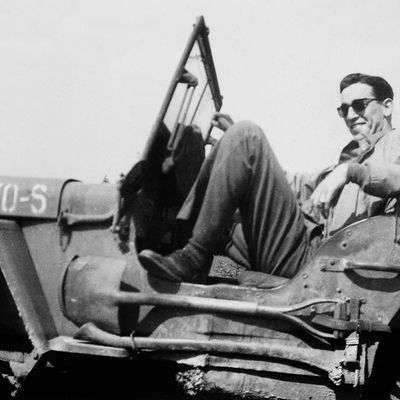
ItÔÇÖs a good thing J.D. Salinger isnÔÇÖt around to see Shane SalernoÔÇÖs bio-documentary Salinger or heÔÇÖd come after Salerno with a hatchet. He really would. ItÔÇÖs not that itÔÇÖs a completely terrible film. ThereÔÇÖs a fair amount of juicy gossip (especially about SalingerÔÇÖs ÔÇ£closet of little girlsÔÇØ) and new information about what might be in the pipeline in terms of fiction written after 1965. (Two unnamed sources say a lot, and it will be published between 2015 and 2020.) ItÔÇÖs just that the movie is everything ÔÇö in a single place, perfectly distilled ÔÇö that made SalingerÔÇÖs skin crawl enough to renounce the world, move to Cornish, New Hampshire, and stop publishing. And the fact that the movieÔÇÖs focus is how and why he renounced the world, moved to Cornish, New Hampshire, and stopped publishing makes it worse, somehow. Salerno probably didnÔÇÖt mean it this way, but he gives you the impression he came to mock his subject: WeÔÇÖve got you now, you antisocial bastard.
Why would Salerno open with a Newsweek photographer reenacting the day in the late seventies when he sat in his car outside a post office waiting to grab a photo of the Man Who Refused to be Photographed? ThatÔÇÖs SalernoÔÇÖs way into SalingerÔÇÖs life? Much time is given to people who stalked and accosted the author on his way to the mailbox or while walking his dog: One guy still maintains that Salinger had a responsibility to counsel those millions of people who took Holden Caulfield so much to heart. Salerno takes no evident position on the matter. He really doesnÔÇÖt.
Salinger is being released in tandem with an oral biography (orchestrated quotes) that aims to break news. I almost threw the book down when I read that The Catcher in the Rye ÔÇ£can best be understood as a disguised war novel.ÔÇØ ThereÔÇÖs a good case that having managed to survive three of the most horrendous, grisly battles of World War II ÔÇö after which he arrived at Dachau ÔÇö Salinger would write with what weÔÇÖd now call PTSD and a longing to transcend the corrosive material world. But the Rockefeller Center skating rink isnÔÇÖt the Battle of the Bulge. In the movie, Salerno has an actor made up to look like Salinger seated at a manual typewriter on the bare stage of a theater, pecking away while behind him on a screen we see footage of war, skeletal Jewish corpses, etc. Later, the actor lurches through the woods, looking as if heÔÇÖs in search of girls to dismember. No wonder Salinger refused to sell his works to the movies. They always have to find cheap visual correlatives for the movement of the spirit.
Salerno did find Jean Miller, the youngest (age 14) that we know of in a long line of doe-eyed beauties supposedly meant to replace the longed-for Oona OÔÇÖNeill, whoÔÇÖd gone off and married Charlie Chaplin while Salinger was dodging Nazi bullets. Miller says Salinger struck up a conversation with her by a pool while she was reading Wuthering Heights. He would tell her she inspired his Esme. Years later (when she was legal), she initiated sex, after which he broke it off, allegedly because she expressed sadness that he had to go back home to write. Sounds like a line to me, but I wasnÔÇÖt there. Others of MillerÔÇÖs ilk followed. Salinger wrote to Joyce Maynard when he saw her on the cover of a magazine. He liked pretty young girls. Stop the presses.
Some of the talking heads ÔÇö among them Gore Vidal, Ben Yagoda, Michael Silverblatt, Phoebe Hoban, and various Salinger biographers ÔÇö talk well. E.L. Doctorow says becoming a recluse was a great P.R. device. More puzzling is the presence of actors like John Cusack, Edward Norton, Philip Seymour Hoffman, and Martin Sheen. Salerno would probably have asked Snooki if he thought she could help sell the movie. John Guare does his own work a disservice in the atrocious section about how Holden Caulfield inspired Mark David Chapman, John Hinckley, and another killer to develop a murderous rage against phonies. Guare says if it happens once, okay, thatÔÇÖs life, but three psychos citing your work should make you worry. This certainly puts GuareÔÇÖs young alter ego ÔÇö a basket-case soldier with a bomb meant for the Pope in The House of Blue Leaves ÔÇö in perspective but misses as badly as Chapman, Hinckley, et al. in explaining the greatness of The Catcher in the Rye, in which HoldenÔÇÖs anger is always getting gummed up by flashes of empathy and a dream of saving children from going off the cliff into the real (grown-up, ghastly) world.
The movie has certainly made me eager to dip into Vedantic philosophy, which calls for renouncing the world and became, according to Salerno, the organizing principle of SalingerÔÇÖs life and work. IÔÇÖll start by renouncing Salinger.


